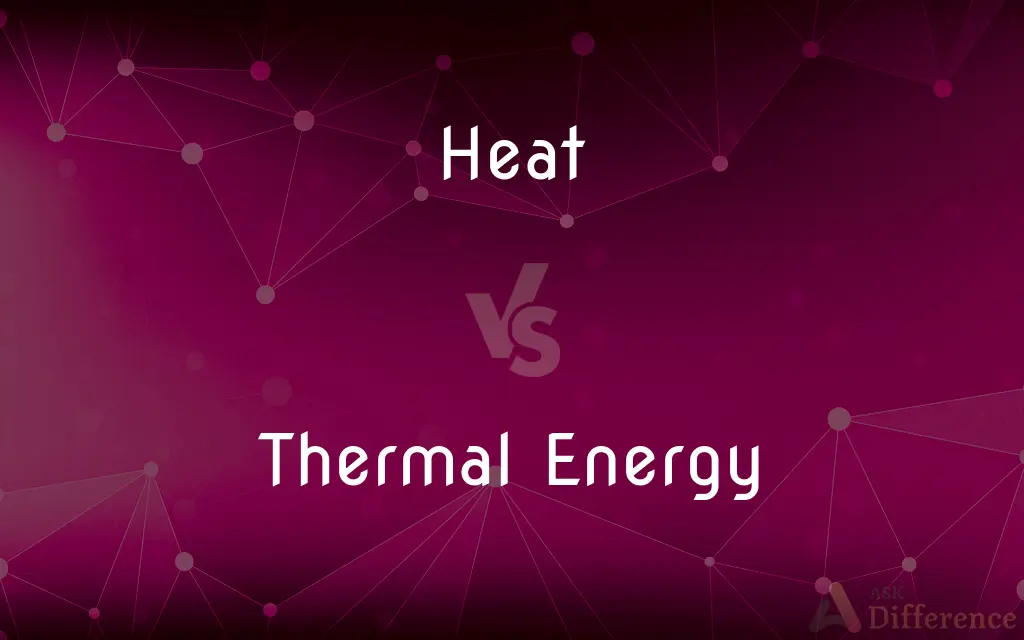Heat vs. Thermal Energy — What's the Difference?
Edited by Tayyaba Rehman — By Maham Liaqat — Published on March 3, 2024
Heat is the transfer of thermal energy between objects of different temperatures, moving from warmer to cooler objects, while thermal energy is the total internal energy within an object, resulting from the movement of its particles.

Difference Between Heat and Thermal Energy
Table of Contents
ADVERTISEMENT
Key Differences
Heat and thermal energy are fundamental concepts in thermodynamics but serve different roles. Thermal energy refers to the total internal kinetic and potential energy of the particles within a substance due to their random motions. It is a measure of the total amount of energy (both kinetic and potential) contained within an object and depends on the object's temperature, mass, and the state of the matter. Higher temperatures or larger masses result in greater thermal energy.
Heat, in contrast, is energy in transit. It is the process of energy moving from one body or system to another as a result of their temperature difference. Heat flows naturally from a hotter object to a cooler one until thermal equilibrium is reached, where both objects have the same temperature. This flow can occur via conduction, convection, or radiation and is measured in units of energy, such as joules or calories.
The distinction between these concepts is crucial for understanding thermodynamic processes. For instance, when heat is added to a system, it increases the system's thermal energy, leading to a rise in temperature or a change in state (such as melting or boiling) if the temperature remains constant. The increase in thermal energy results from the increased kinetic energy of the particles within the system.
It's also important to note that while all objects contain thermal energy as long as their temperature is above absolute zero (-273.15°C or -459.67°F), heat is only present when there is a temperature difference and thus a transfer of energy. In essence, thermal energy is a property of an object, while heat is a phenomenon occurring between objects.
Understanding the relationship between heat and thermal energy is essential for grasping how energy transfers lead to changes in temperature and state in various physical and engineering contexts, such as in heating systems, engines, and environmental science.
ADVERTISEMENT
Comparison Chart
Definition
Transfer of energy due to temperature difference
Total internal energy within an object due to particle motion
Depends on
Temperature difference between objects
Object's temperature, mass, and state
Measurement
Joules, calories (energy units)
Joules (based on temperature, mass)
Flow
From warmer to cooler objects until equilibrium
Contained within an object; does not flow
Role in Thermodynamics
Process of energy transfer
A measure of internal energy
Compare with Definitions
Heat
The energy transferred between objects due to a temperature difference.
Placing a cold spoon in hot soup transfers heat to the spoon.
Thermal Energy
Influenced by temperature, mass, and substance type.
The thermal energy of a swimming pool is greater than that of a bathtub due to its larger volume of water.
Heat
Measured in joules or calories, indicating energy in transit.
The heat from the sun warms the Earth's surface.
Thermal Energy
Exists in all matter above absolute zero.
Even ice has thermal energy as its particles are still vibrating.
Heat
Can cause changes in temperature or state when absorbed or released.
Melting ice absorbs heat without changing temperature.
Thermal Energy
The total internal energy of an object from its particles' motion.
A hot cup of tea has more thermal energy than a cold one.
Heat
Flows naturally from hot to cold bodies.
Heat flows from the hot coffee to the surrounding air.
Thermal Energy
Increases with temperature rise.
Heating a metal rod increases its thermal energy.
Heat
Observed through effects on substances' temperature and state.
Boiling water involves transferring heat to increase water's thermal energy.
Thermal Energy
Determines the substance's state (solid, liquid, gas).
The thermal energy of water determines if it is ice, liquid water, or steam.
Heat
A form of energy associated with the kinetic energy of atoms or molecules and capable of being transmitted through solid and fluid media by conduction, through fluid media by convection, and through empty space by radiation.
Heat
The transfer of energy from one body to another as a result of a difference in temperature or a change in phase.
Heat
The sensation or perception of such energy as warmth or hotness.
Heat
The condition of being hot.
Heat
A degree of warmth or hotness
The burner was on low heat.
Heat
To make warm or hot.
Heat
To make hot; to communicate heat to, or cause to grow warm; as, to heat an oven or furnace, an iron, or the like.
Heat me these irons hot.
Heat
To grow warm or hot by the action of fire or friction, etc., or the communication of heat; as, the iron or the water heats slowly.
Heat
A form of energy that is transferred by a difference in temperature
Common Curiosities
How do insulators affect heat transfer?
Insulators slow down the transfer of heat by reducing the rate of thermal energy flow between objects.
How is thermal energy transferred between objects?
Thermal energy is transferred through the process of heat (conduction, convection, radiation) due to a temperature difference.
How do specific heat and thermal energy relate?
Specific heat is the amount of heat per unit mass required to raise the temperature by one degree Celsius and affects how much thermal energy a substance can store.
Does adding heat always increase temperature?
Not always; adding heat can change the state of a substance (like melting or boiling) at constant temperature.
How do living organisms utilize thermal energy?
Living organisms metabolize food to generate thermal energy, maintaining body temperature and supporting life processes.
Can heat exist without a temperature difference?
No, heat requires a temperature difference to flow between two objects or systems.
Can thermal energy be converted to other forms of energy?
Yes, thermal energy can be converted into mechanical energy in engines or electrical energy in thermoelectric generators.
What is the zeroth law of thermodynamics about?
It states that if two systems are each in thermal equilibrium with a third system, they are in thermal equilibrium with each other.
What role does thermal energy play in phase changes?
During phase changes, thermal energy is absorbed or released, facilitating transitions between solid, liquid, and gas states without temperature change.
Is thermal energy the same as temperature?
No, thermal energy is related to the total internal energy of an object, while temperature measures the average kinetic energy of the particles.
Why is understanding heat and thermal energy important?
It's crucial for applications in heating and cooling systems, understanding weather patterns, designing energy-efficient buildings, and many areas of science and engineering.
Can objects at the same temperature have different thermal energies?
Yes, because thermal energy also depends on mass and the type of substance, not just temperature.
Is it possible to transfer thermal energy directly?
Thermal energy itself is not transferred; the transfer occurs via heat due to temperature differences.
How does the environment affect heat transfer?
Environmental factors like temperature gradients, humidity, and wind speed can influence the rate and direction of heat transfer.
What is absolute zero in terms of thermal energy?
Absolute zero is the theoretical temperature at which an object's particles have minimal kinetic energy, and thus the object contains minimal thermal energy.
Share Your Discovery

Previous Comparison
Economic Profit vs. Normal Profit
Next Comparison
Single Stage Furnace vs. Two Stage FurnaceAuthor Spotlight
Written by
Maham LiaqatEdited by
Tayyaba RehmanTayyaba Rehman is a distinguished writer, currently serving as a primary contributor to askdifference.com. As a researcher in semantics and etymology, Tayyaba's passion for the complexity of languages and their distinctions has found a perfect home on the platform. Tayyaba delves into the intricacies of language, distinguishing between commonly confused words and phrases, thereby providing clarity for readers worldwide.
















































